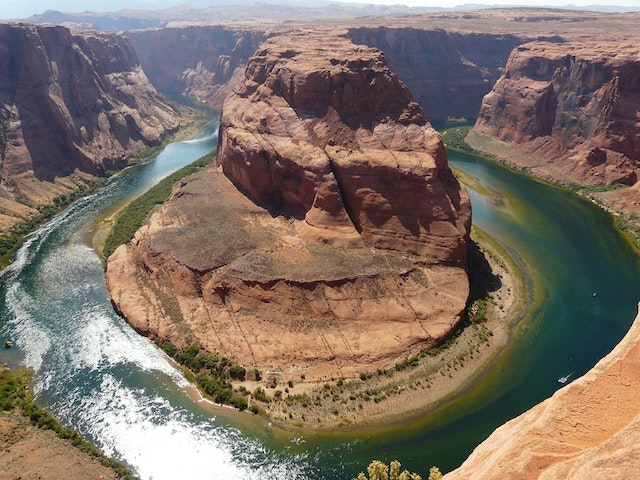
Why is the Grand Canyon so deep? Because of the power of the Colorado River, the amount of water in it, the arid climate, and the rocks it is made of.
The Grand Canyon carves through the Colorado Plateau. It is 446 km long, 29 km wide, and 1,857 m deep at its deepest point. The Colorado River probably started to cut out the canyon about 5.3 million years ago and the whole canyon was probably cut out by 1.2 million years ago.
To understand how the Colorado River was able to cut out the Grand Canyon, we need to look at how the Colorado Plateau formed. Conveniently, the Grand Canyon has been cut so clearly that almost all of the layers of rock are visible. The first layer are the basement rocks and they were formed about 1.72 billion years ago when two continental plates collided and crushed several rows of volcanic islands. The pressure was so high that the rocks fused. I said almost all of the rock layers are visible, but the next billion years is missing. This could be because no deposits were laid down, which is unlikely, or because erosion has erased all traces of those deposits. Next, we have the Grand Canyon Supergroups, which are thick layers of rock. The continental shelf moved again and the whole Grand Canyon Supergroup was tilted by about 45 degrees. By this time, the whole area was under a shallow sea and the next layers of rock were made when sediment sank to the bottom of the sea. The rock is limestone and has fossils of algae and other sea life. More and more layers of rock were added, giving all of the layers that can be seen today.
Then, about 60 million years ago, the Pacific and the North American tectonic plates came together and thrust the entire Colorado Plateau between 1,500 and 3,000 m up into the air. When two plates meet, it can thrust the ground up to make mountain ranges, but, in the case of the Colorado Plateau, the whole area was pushed up as one piece, making the flat plateau.
So, why is the Grand Canyon so deep? It is all to do with the height of the Colorado Plateau and the power that height gives to the Colorado River. The Colorado River started flowing about 50 million years ago when the Rocky Mountains were formed. Until then, most of America was underwater. The Colorado River flowed down from the east side of the mountains and out to sea, somewhere along the Californian coast. By 6 million years ago when the Colorado Plateau began to rise, the river had found the course that it still follows today. When land rises due to tectonic plates, some rivers will move, but some rivers will keep the same course. The Colorado River continued on the same course.
The Colorado Plateau was pushed up so slowly that the river didn’t have any trouble flowing. However, as the ground started to move up, the river picked up speed. If you have a pipe of water and raise one side of the pipe, the water coming out of the other end is going to be much faster. This is what happened to the Colorado River. As the plateau was pushed up, the river picked up speed and power and a faster river has far more erosive power than a slower river. Because the river had more power, it could carry large rocks and boulders, which smashed into the river sides and bed, breaking it up, before the pieces were carried away by the fast-moving river.
The Colorado River doesn’t just move fast, it carries a large amount of water. When it floods, an enormous amount of water moves along the river, which gives it even more erosive power. Back when the canyon was first forming, the Ice Age was finishing and there was a lot of glacial meltwater in the river as well.
All of these things were helped by the arid climate of Colorado. If the area had had a more temperate climate, there would have been more trees and vegetation which hold the ground together with their roots. Erosion is a much faster process when there aren’t many plants. A river can carve up exposed rock much more easily.
And, lastly, the type of rock was a factor. The upper layers of rock were made when sediment was laid down in the oceans. This type of rock is not very hard and easily erodes. These days, the river has pretty much got as deep as it can get because the lower basements rocks are very hard and not easily eroded.
So, the Grand Canyon was eroded over four million years, give or take, and it was eroded by the Colorado River as the plateau it is on was pushed into the sky. The river sliced through it like a cake being pushed around a wire. And this is what I learned today.
Photo by Pixabay: https://www.pexels.com/photo/horseshoe-bend-photo-86703/
Sources
https://en.wikipedia.org/wiki/Grand_Canyon
https://en.wikipedia.org/wiki/Colorado_Plateau
https://knowablemagazine.org/article/physical-world/2019/deeper-understanding-grand-canyon
https://www.nps.gov/grca/learn/nature/grca-geology.htm
